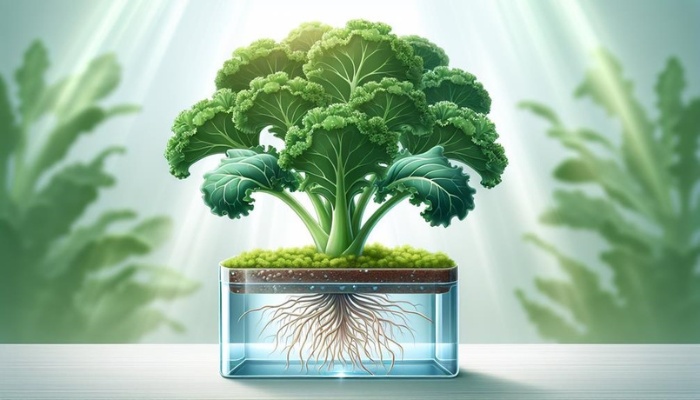Did you know that hydroponically grown vegetables can reach maturity up to 25% faster than their soil-grown counterparts?
Among these, kale stands out as a nutrient-rich option that thrives in a soilless environment, offering you a constant supply of fresh greens.
By embracing hydroponics, you’re not just sidestepping the mess and limitations of traditional gardening; you’re stepping into the world of efficient, year-round production.
Understanding Hydroponics
Hydroponics, a soil-less farming method, allows you to grow plants using nutrient-rich water solutions. This technique hinges on maintaining optimal water quality and precisely formulated nutrient solutions.
When you begin hydroponics, you bypass traditional soil and engage in a science that tailors the growing environment to your plants’ needs.
Water quality is paramount in hydroponics. You must ensure the water is free from contaminants that could harm your plants. This involves regular testing and treatment to maintain the right pH and nutrient levels.
The ideal pH range for most hydroponic systems hovers between 5.5 and 6.5, allowing for optimal nutrient uptake.
Nutrient solutions, the lifeline of hydroponically grown plants, must be well balanced. These solutions provide the essential minerals and vitamins that plants typically draw from soil.
You’ll mix a concentrated solution with water, creating a perfect blend that feeds your plants directly through their roots. This direct feeding mechanism accelerates growth and can lead to more robust plants.
Understanding these elements is essential before you dive into growing kale or any other plant hydroponically. It sets the stage for a successful harvest by ensuring your plants receive everything they need in a controlled environment.
Benefits of Growing Kale Hydroponically
Growing kale hydroponically offers substantial advantages, including accelerated growth and higher nutrient content.
This method, devoid of soil, streamlines the cultivation process and amplifies the health benefits associated with this leafy green.
Here are three key benefits you’ll enjoy:
- Faster Growth Rates: Hydroponically grown kale reaches maturity quicker than its soil-grown counterparts. The direct delivery of nutrients and water to the roots stimulates faster growth, allowing you to harvest your greens in a shorter time frame.
- Enhanced Nutrient Content: Nutritional analysis shows that hydroponic kale often contains higher levels of vitamins and minerals. This is due to the controlled environment, which can be optimized for the specific needs of different kale varieties, ensuring they develop to their full nutritional potential.
- Year-Round Harvests: Without the limitations of traditional outdoor gardening, you can grow kale throughout the year. This constant production ensures a steady supply of fresh, nutrient-rich greens regardless of the season.
Setting Up Your Hydroponic System
To set up your hydroponic system for kale, you’ll first need to choose the right type of system that suits your space and budget constraints.
There are several hydroponic methods available, including deep water culture (DWC), ebb and flow, and nutrient film technique (NFT). Each has its own advantages, depending on your specific needs.
Once you’ve selected the system, you’ll need to focus on lighting options. Kale requires ample light to thrive, making LED grow lights a popular choice due to their efficiency and lower heat output.
Position the lights to ensure even coverage, mimicking natural sunlight conditions as closely as possible.
Nutrient solutions are the lifeblood of your hydroponic kale. A balanced mix catering specifically to leafy greens is essential. Look for solutions that provide a comprehensive range of macro and micronutrients.
Your solution’s pH level should also be monitored regularly. Aim for a range between 5.5 and 6.5 to optimize nutrient uptake.
Caring for Your Hydroponic Kale
Once your hydroponic system is up and running, monitor your kale’s growth closely, ensuring it receives the right balance of nutrients and light for optimal health.
Your kale demands a delicate balance in its environment to thrive. Here are essential aspects to focus on:
- pH Management: The pH level of your water significantly affects kale’s ability to absorb nutrients. Maintain a pH range between 5.5 and 6.5. Regular testing and adjustments, if necessary, ensure the nutrient solutions are within this optimal range for kale absorption.
- Nutrient Solutions: Hydroponic kale relies entirely on the nutrient solution for its growth. Use a complete hydroponic nutrient solution that’s rich in nitrogen, potassium, and calcium, vital for leaf development and health. Regularly change the nutrient solution every two weeks to prevent nutrient imbalances and buildup of harmful substances.
- Lighting Requirements: Kale needs ample light to photosynthesize and grow. Ensure your hydroponic system is equipped with high-quality grow lights, providing at least 12 to 16 hours of light daily. Adjust the positioning of lights as your kale grows to prevent overshadowing and to promote uniform growth.
Caring for your hydroponic kale with precision in these areas guarantees a healthy, vibrant crop ready for your kitchen.
Harvesting and Using Your Kale
After weeks of caring for your hydroponic kale, it’s now time to harvest and enjoy the fruits of your labor. Harvesting should be done early in the morning when the leaves are most crisp.
Gently cut the outer leaves, leaving about 2 inches of stem for regrowth. Before harvesting, ensure your kale plants are free from pests; integrated pest management strategies are key in hydroponics to maintain healthy growth.
From smoothies to salads, the versatility of kale makes it a staple in any health-conscious kitchen. Remember that fresh kale from your hydroponic system retains more nutrients, making your recipes not just tastier but also more nutritious.
To help you get started, here’s a simple table outlining a few ways to use your kale:
| Use | Preparation | Tips |
|---|---|---|
| Smoothies | Blend with fruits | Freeze kale for a thicker texture |
| Salads | Raw, chopped | Massage with dressing to soften |
| Cooking | Sautéed or baked | Pair with garlic for extra flavor |
Incorporating kale into your diet is straightforward. With the right pest management and harvesting techniques, you’ll enjoy the full benefits of your hydroponic kale.

